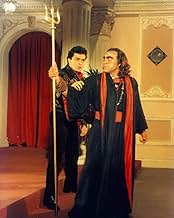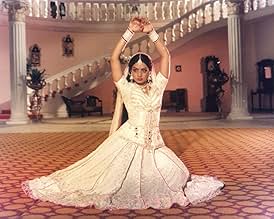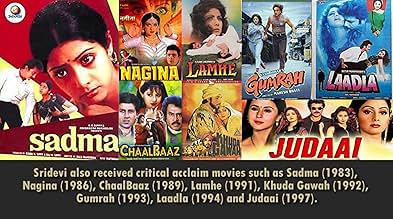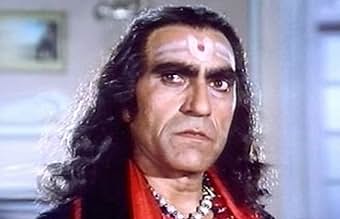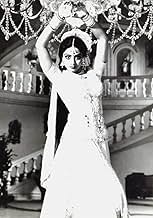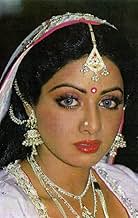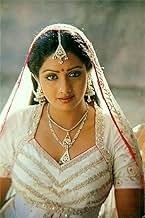IMDb रेटिंग
6.4/10
1.3 हज़ार
आपकी रेटिंग
यह कहानी एक इच्छाधारी नागिन रजनी के इर्द गिर्द घूमती है, जो एक आम आदमी से शादी करती है, ताकि वह एक दुष्ट साधु से अपने पति की मौत का बदला ले सके.यह कहानी एक इच्छाधारी नागिन रजनी के इर्द गिर्द घूमती है, जो एक आम आदमी से शादी करती है, ताकि वह एक दुष्ट साधु से अपने पति की मौत का बदला ले सके.यह कहानी एक इच्छाधारी नागिन रजनी के इर्द गिर्द घूमती है, जो एक आम आदमी से शादी करती है, ताकि वह एक दुष्ट साधु से अपने पति की मौत का बदला ले सके.
- निर्देशक
- लेखक
- स्टार
- पुरस्कार
- कुल 1 जीत
Komal Mahuvakar
- Vijaya Singh
- (as Komal Madhuvakar)
फ़ीचर्ड समीक्षाएं
10 stars for unforgettable performance of Sridevi.2 stars deducted as I dont understand why Rajiv hit Nagina when he saw her whirling helplessly.
This movie is definitely a classic. I used to love watching it as a kid. If you are willing to suspend your disbelief or if you are a little kid, you'll like the movie. If you like snakes, you might like the movie. It's about a woman who can turn into a snake. It's great.
The role of the Snake-Woman had been rejected by many leading ladies of the mid '80s. Most of them were unwilling to take a risk in their fairly new but stable careers by signing a film which had a story and screenplay written by two newcomers and a not-so-successful producer/director. Although Harmesh Malhotra has gone on record to say that he was very disappointed at the response he'd received from his fellow industry members, the audience were too entranced by Sridevi's performance to be worried about the "what-ifs?!" In fact, it's hard to imagine Nagina without Sridevi so I find it very difficult to understand why Malhotra hadn't approached her for this role in the first place? Much has been written about how this is the film that "made" Sridevi. I totally disagree as I firmly believe instead that Sridevi "made" the film. Her dedication and professionalism seeps through the entire film and its apparent that only an actor of her calibre could execute such a strong performance from a questionable script and low-budgeted film.
Ten years earlier, "Nagin" with it's snake-woman storyline only succeeded because it was a multi-starrer film and the snake assumed the form of almost every female actor that was in the star cast. And if that wasn't confusing enough, the audience couldn't decide if their sympathies lied with the Nagin (who was revenging the loss of her beloved but ultimately killed herself) or with the male characters that were being killed off one-by-one by her? Was the Nagin the villain or not who knows? Who cares? In "Nagina" however, there is a steady build-up to the character played by Sridevi and it's not until two-thirds of the film is complete, and the emergence of Amrish the Sapera that we realise that she is actually a snake-woman. Before that, we assume that Sri and Rishi are reincarnated as lovers who have the protection of two snakes for a nearby derelict mandir.
Or, we're led to believe that it's a film about an inheritance dispute with Prem Chopra swindling Rishi's family out of their wealth. But, we realise later that Prem isn't the main villain at all.
And then, we assume that the film is about Saas-Bahu relationship as Sushma Seth, the mother-in-law doesn't accept her son's choice of spouse. But even here, we're proved wrong as Sushma warms to her bahu as soon as she sees her.
If these red-herrings aren't enough, Sridevi, in the first portion of the film appears extremely subdued and mellow in comparison to all the other films that we've previously seen her in. Not only does she sound different (this being one of the first Hindi films that she actually used her own voice and wasn't dubbed for) but also, you'll notice from the first three songs, that her dancing is at a slower pace and without the jhatkas-matkas that are always expected from her.
With any other film, the audience would probably get confused with the plot and walk out of the theatre. But "Alak Niranjan", in walks Amrish Puri with his snake sniffing skills and his magical "been" and to everyone's surprise (not at least the Mother in Laws), Sridevi reveals the other side of her character.
Then in every scene that follows, we get more excited seeing her transform from a loving pativrata nari into a Nag-Goddess, protecting her husband and family. The icing on the cake, of course, is the powerful dance at the end. A combination of her large expressive eyes, the hypnotising music and Sridevi's tremendous ability to captivate her audience but without being influenced by the Sapera, leaves the audience wanting more.
And trade-figures prove that the audience came back regularly to see more of their screen-goddess in this semi-mythological but modernly adapted character. In fact, this was the most popular film and successful film of that year. It's a shame that the "popular awards of Indian cinema" failed to recognise this. Luckily, Malhotra didn't as he made a sequel called "Nigahen" three years later which consolidated his position as an established film-maker and made him the proud recipient of an award.
Needless to say, Malhotra too became a devotee of Sridevi after worked with her in Nagina. In addition to Nigahen, he made Sherni, Banjaran and Heer Ranjha with Sridevi, and this time, for all these films, he made sure that she was given first-refusal!!
Ten years earlier, "Nagin" with it's snake-woman storyline only succeeded because it was a multi-starrer film and the snake assumed the form of almost every female actor that was in the star cast. And if that wasn't confusing enough, the audience couldn't decide if their sympathies lied with the Nagin (who was revenging the loss of her beloved but ultimately killed herself) or with the male characters that were being killed off one-by-one by her? Was the Nagin the villain or not who knows? Who cares? In "Nagina" however, there is a steady build-up to the character played by Sridevi and it's not until two-thirds of the film is complete, and the emergence of Amrish the Sapera that we realise that she is actually a snake-woman. Before that, we assume that Sri and Rishi are reincarnated as lovers who have the protection of two snakes for a nearby derelict mandir.
Or, we're led to believe that it's a film about an inheritance dispute with Prem Chopra swindling Rishi's family out of their wealth. But, we realise later that Prem isn't the main villain at all.
And then, we assume that the film is about Saas-Bahu relationship as Sushma Seth, the mother-in-law doesn't accept her son's choice of spouse. But even here, we're proved wrong as Sushma warms to her bahu as soon as she sees her.
If these red-herrings aren't enough, Sridevi, in the first portion of the film appears extremely subdued and mellow in comparison to all the other films that we've previously seen her in. Not only does she sound different (this being one of the first Hindi films that she actually used her own voice and wasn't dubbed for) but also, you'll notice from the first three songs, that her dancing is at a slower pace and without the jhatkas-matkas that are always expected from her.
With any other film, the audience would probably get confused with the plot and walk out of the theatre. But "Alak Niranjan", in walks Amrish Puri with his snake sniffing skills and his magical "been" and to everyone's surprise (not at least the Mother in Laws), Sridevi reveals the other side of her character.
Then in every scene that follows, we get more excited seeing her transform from a loving pativrata nari into a Nag-Goddess, protecting her husband and family. The icing on the cake, of course, is the powerful dance at the end. A combination of her large expressive eyes, the hypnotising music and Sridevi's tremendous ability to captivate her audience but without being influenced by the Sapera, leaves the audience wanting more.
And trade-figures prove that the audience came back regularly to see more of their screen-goddess in this semi-mythological but modernly adapted character. In fact, this was the most popular film and successful film of that year. It's a shame that the "popular awards of Indian cinema" failed to recognise this. Luckily, Malhotra didn't as he made a sequel called "Nigahen" three years later which consolidated his position as an established film-maker and made him the proud recipient of an award.
Needless to say, Malhotra too became a devotee of Sridevi after worked with her in Nagina. In addition to Nigahen, he made Sherni, Banjaran and Heer Ranjha with Sridevi, and this time, for all these films, he made sure that she was given first-refusal!!
This movie is great. It has a great story and it is one of the best Hindi movies of all time. It stars Sri Devi, Rishi Kapoor and Amrish Puri. Sri Devi does excellent acting and Amrish Puri portrays the sage perfectly. I think that everybody that likes Hindi movies should watch this.
I like this film. To me, it's about not paying attention to others when they speak ill of your relatives. Interesting and different film.
क्या आपको पता है
- ट्रिवियाJaya Pradha was approached for the lead role but she refused because she was scared of snakes.
- गूफ़Throughout the entire film, the old haveli is depicted as mostly walls with a few windows. Although it has one floor, there are no rooms on that level, making it feel empty. It seems the art director might have been working with a limited budget, leading to cost-cutting measures. Interestingly, while there's a fountain placed at the center of the haveli, there are no actual rooms to complement the structure.
- कनेक्शनEdited into Nigahen: Nagina Part II (1989)
- साउंडट्रैकAaj Kal Yaad Kucch Aur Rahta Nahin
Sung by Mohammed Aziz
Music composed by Laxmikant Shantaram Kudalkar and Pyarelal Ramprasad Sharma (as Laxmikant Pyarelal)
Lyrics by Anand Bakshi
टॉप पसंद
रेटिंग देने के लिए साइन-इन करें और वैयक्तिकृत सुझावों के लिए वॉचलिस्ट करें
- How long is Nagina?Alexa द्वारा संचालित
विवरण
- चलने की अवधि2 घंटे 17 मिनट
- ध्वनि मिश्रण
- पक्ष अनुपात
- 1.37 : 1
इस पेज में योगदान दें
किसी बदलाव का सुझाव दें या अनुपलब्ध कॉन्टेंट जोड़ें

